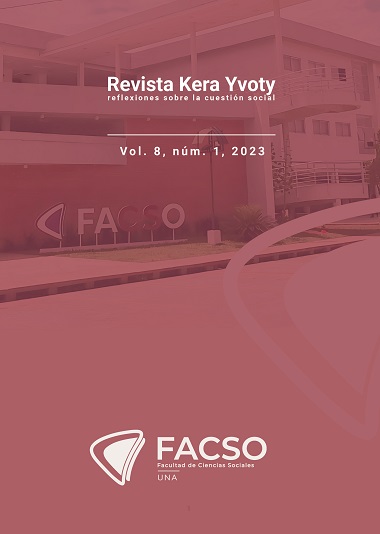Abstract
The sociolinguistic structure is made up of language, its use and development within a social and cultural environment, framed by the time-space factor. This paper aims to investigate within the Paraguayan educational system the way in which its action produces and reproduces the sociolinguistic structure. For this purpose, the paper proposes the use of a qualitative, descriptive, cross-sectional methodology. The technique employed was the in-depth interview and the instrument was a questionnaire of 13 open-ended questions. As for the population, the study considered for the study were Basic School Nº 712 San Francisco de Asís and Basic School Nº 1085 Private Subsidized Parochial School La Inmaculada, both located in the district of Eusebio Ayala, Department of Cordillera, in the year 2021, in which there were three teachers and three school principals, 12 students with their respective parents. As a finding, it was determined that, being a diglossic bilingual culture, the educational system, through the school and its agents, reproduces this structure insofar as it responds to the dominant language. As a conclusion, it is established that based on the sociolinguistic element of cultural domain, called diglossia, the educational system proposes the structure of the educational components and on its influence, the subjectivities of the subjects are constructed and reconstructed. Linguistic competences are built on the foundations of the dominant cultural capital and this guides the course of the educational system.
References
Berger, P., y Luckmann, T. (2003). La construcción social de la realidad (Vol. 975). Editorial Amorrortu.
Bernstein, B. (1988). Clases, códigos y control II (Vol. 2). Ediciones AKAL.
Bourdieu, P., y Passeron, J. (2° Ed.). (1996). La reproducción: elementos para una teoría del sistema de enseñanza. Editorial Laia.
Consejo Nacional den Educación y Cultura, CONEC. (2007), Informe Sobre la Situación de la Educación Paraguaya, Ediciones del CONEC.
Corvalán, G. (2018), El bilingüismo en la educación en el Paraguay: ¿es creativo u opresivo? En G. Corvalán, y G. Granda (Eds.). Sociedad y Lengua: Bilingüismo en el Paraguay. Tomo 1. (pp. 195-233). Editorial Ediciones y Arte.
Gomes-Pires, D. O., y Cathcart-Roca, M. L. (2011). Cabo verde: lengua, cultura e identidad y su relación con la educación. Ciencia en su PC, (4), 122-136.
Granda, G. (1981). Actitudes sociolingüísticas en el Paraguay. En G. Corvalán, y G. Granda (Eds.). Sociedad y Lengua: Bilingüismo en el Paraguay. Tomo 1. (pp. 487-488). Editorial Ediciones y Arte.
Harguindéguy, J. B., & Ballester López, M. (2007). Acción colectiva y enseñanza de las lenguas regionales en Francia (1951-2006). Una primera aproximación. Revista Española de Ciencia Política, 16, 89-108.
Lusting, W. (1996). Guarani, el Paraguay, Mba’éichapa oiko la guarani? Papia: revista de crioulos de base ibérica. (4).
Ministerio de Educación y Ciencias, MEC. (2014). Programa de Estudio, Área Lengua y Literatura Castellana 9° Grado.
Moscoso, F. (2015). El árabe ceutí, una lengua minorizada de España. Estudios de Asia y África, 50(2), 395-423.
Ortiz Sandoval, L. (2012). Educación y Desigualdad. Las clases desfavorecidas ante el sistema educativo paraguayo. Centro de Estudios Antropológicos de la Universidad Católica.
Rubin, J. (1963). National bilingualism in Paraguay. Yale University.

This work is licensed under a Creative Commons Attribution 4.0 International License.
Copyright (c) 2023 Julio Vega (Autor/a); Luis Ortiz




